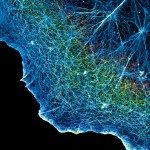Link to Pubmed [PMID] – 16679358
Biophys. J. 2006 Aug;91(4):1169-91
Cells contain many subcellular structures in which specialized proteins locally cluster. Binding interactions within such clusters may be analyzed in live cells using models for fluorescence recovery after photobleaching (FRAP). Here we analyze a three-dimensional FRAP model that accounts for a single spatially localized cluster of binding sites in the presence of both diffusion and impermeable boundaries. We demonstrate that models completely ignoring the spatial localization of binding yield poor estimates for the binding parameters within the binding site cluster. In contrast, we find that ignoring only the restricted axial height of the binding-site cluster is far less detrimental, thereby enabling the use of computationally less expensive models. We also identify simplified solutions to the FRAP model for limiting behaviors where either diffusion or binding dominate. We show how ignoring a role for diffusion can sometimes produce serious errors in binding parameter estimation. We illustrate application of the method by analyzing binding of a transcription factor, the glucocorticoid receptor, to a tandem array of mouse mammary tumor virus promoter sites in live cells, obtaining an estimate for an in vivo binding constant (10(-7) M), and a first approximation of an upper bound on the transcription-factor residence time at the promoter (approximately 170 ms). These FRAP analysis tools will be important for measuring key cellular binding parameters necessary for a complete and accurate description of the networks that regulate cellular behavior.


